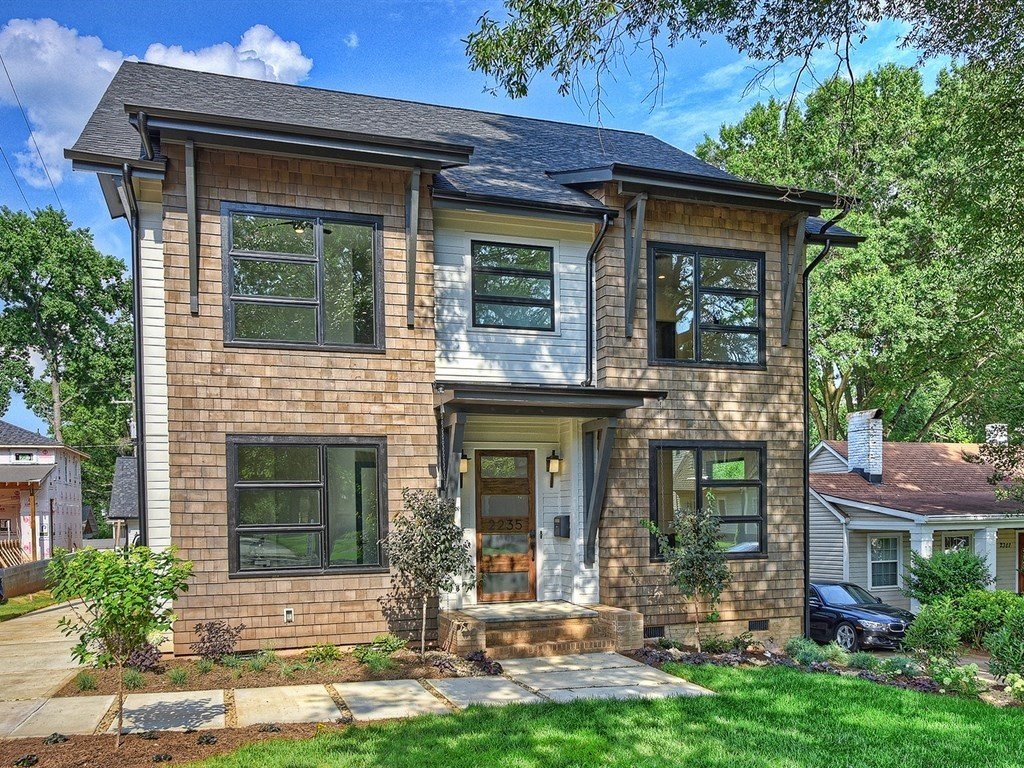Contemporary Craftsman homes represent a captivating blend of classic artistry and modern practicality. They capture the enduring appeal of the Arts & Crafts movement while embracing the open, airy layouts and updated amenities of contemporary design. This harmonious fusion creates homes that are both timeless and perfectly suited to modern living. Let’s explore the defining characteristics, design principles, and practical considerations that make Contemporary Craftsman homes so appealing.
Defining the Contemporary Craftsman Aesthetic
Contemporary Craftsman homes draw inspiration from the original American Craftsman movement, which emphasized handcrafted details, natural materials (wood, stone, and brick), and a strong connection to nature. This design philosophy is carried forward in the contemporary iteration, with a renewed focus on functionality and modern living. Key architectural features, such as gables (often multiple), exposed rafters, prominent porches, tapered columns, and decorative brackets, maintain a visual link to the Craftsman heritage.
The contemporary twist comes in the form of open floor plans, cleaner lines, larger windows, updated kitchens and bathrooms, and a focus on incorporating modern conveniences. This evolution reflects a shift towards more spacious and light-filled living areas, while still retaining the warmth and character of the Craftsman tradition. Immerse yourself in the exquisite world of contemporary craftsman houses for a deeper understanding of this captivating style.
Crafting Curb Appeal: Exterior Design Elements
The exterior of a Contemporary Craftsman home is carefully curated to create a welcoming and stylish first impression. Color palettes, while often rooted in the earthy tones of traditional Craftsman homes, may explore bolder choices in contemporary designs. Examples from design firms like brick&batten include using Benjamin Moore’s Seapearl (a soft off-white) for trim against a darker exterior like Sherwin Williams’ Urbane Bronze. Black trim is also a popular and striking choice, offering a contemporary contrast to natural siding materials.
Speaking of materials, stone and siding combinations are frequently employed, incorporating natural textures and adding visual interest. Wood paneling and porch columns maintain the Craftsman connection to nature and provide a warm, organic touch. Landscaping plays a crucial role in integrating the home with its surroundings. Thoughtfully designed gardens and hardscaping elements create inviting outdoor living spaces that extend the home’s footprint and enhance its connection to the natural world. Explore the serene neighborhood of Council Crest for inspiration on integrating homes with natural landscapes.
Inside Story: Interior Design and Layout
Open floor plans are a defining feature of Contemporary Craftsman interiors. They create spacious and airy living areas that encourage a sense of connection and flow between different parts of the home. Natural light is maximized through the strategic placement of large windows, creating bright and inviting spaces. Warm wood accents, often in the form of exposed beams, flooring, or built-in bookshelves and cabinetry, add to the home’s cozy and inviting atmosphere. Some modern Craftsman homes may also include a fireplace, a classic element that provides warmth and a focal point for the living area.
Kitchens and bathrooms receive contemporary updates with modern appliances, fixtures, and finishes. Sleek countertops, updated cabinetry, and energy-efficient appliances blend seamlessly with the Craftsman aesthetic, resulting in spaces that are both beautiful and functional. The emphasis on handcrafted details and quality materials, a hallmark of the Craftsman tradition, is carried through in the interior design, creating a sense of enduring value and personalized style.
The Four Craftsman Subtypes: Exploring the Roots
The Craftsman style encompasses a rich history and several distinct subtypes, each with its own unique characteristics. These subtypes – Mission, Four-Square, Bungalow, and Prairie – offer a glimpse into the evolution of Craftsman architecture and provide a framework for understanding the diverse expressions of this enduring style.
-
Mission Craftsman: Inspired by the Spanish missions of the American Southwest, this subtype features stucco walls, red tile roofs, arched doorways and windows, and decorative ironwork.
-
Four-Square Craftsman: Emphasizing practicality and efficiency, the Four-Square is typically a two-and-a-half-story home with four roughly equal-sized rooms on each floor.
-
Bungalow Craftsman: Perhaps the most iconic Craftsman subtype, the Bungalow is known for its cozy and informal atmosphere, low-pitched roofs, wide eaves, exposed rafters, and inviting porches.
-
Prairie Craftsman: Championed by architect Frank Lloyd Wright, this subtype features strong horizontal lines, low-pitched roofs that blend with the landscape, and open floor plans that emphasize a connection between indoor and outdoor spaces.
It’s important to note that these categories are not always mutually exclusive. Some homes may blend elements of different subtypes, creating unique and personalized interpretations of the Craftsman style. Furthermore, contemporary Craftsman homes often draw inspiration from these historical subtypes while incorporating modern design elements.
Real-World Inspiration: Examples and Case Studies
Exploring real-world examples can provide valuable insights into the diverse possibilities of Contemporary Craftsman design. Builders like Toll Brothers showcase various models, such as the Stewart (Utah), Washington (Oregon), and Cloverdale (Arizona), highlighting the use of trim colors, bold gable colors, and other distinctive features. Videos of luxury modern Craftsman homes, like the one by PAGI Construction (Ottawa), offer a glimpse into interior design and layout. Resources like brick&batten, Houseplans.com, and YourNiftyHome provide further examples and inspiration, showcasing a range of sizes, styles, and design approaches.
Building Your Dream: Finding Plans and Resources
For those considering building a Contemporary Craftsman home, resources like Houseplans.com and Architectural Designs offer a wide selection of plans that cater to various tastes and budgets. These resources allow you to explore different layouts, architectural features, and design options, helping you bring your vision to life. Consulting with an architect or builder can provide further guidance and ensure that your home meets your specific needs and preferences.
The Future of Craftsman: Sustainability and Beyond
Contemporary Craftsman design is not static; it continues to evolve, incorporating new ideas and responding to changing needs. Sustainability is becoming an increasingly important consideration, with many homeowners seeking to incorporate eco-friendly materials and building practices. This aligns perfectly with the Craftsman ethos of connection to nature and responsible living.
Other emerging trends include a focus on regional variations, adapting the Craftsman style to different climates and local architectural traditions. Budget-conscious design is also gaining traction, as homeowners seek ways to achieve the Craftsman look without overspending. DIY projects and adaptations for aging in place are further examples of how the Craftsman style continues to adapt and remain relevant in the 21st century.
The Enduring Appeal of Contemporary Craftsman
Contemporary Craftsman homes offer a unique blend of timeless charm and modern functionality. They represent a thoughtful approach to design, emphasizing quality materials, handcrafted details, and a connection to nature. Whether you’re drawn to the cozy intimacy of a bungalow or the spacious elegance of a larger home, the Contemporary Craftsman style offers a versatile and enduring aesthetic that is likely to continue captivating homeowners for generations to come.
- Memorial Stones for Gardens: A Guide to Creating a Lasting Tribute - April 29, 2025
- Melon Cut Diamonds: A Comprehensive Guide - April 29, 2025
- MarketStreet Lynnfield Stores: A Complete Directory & Shopping Guide - April 29, 2025










